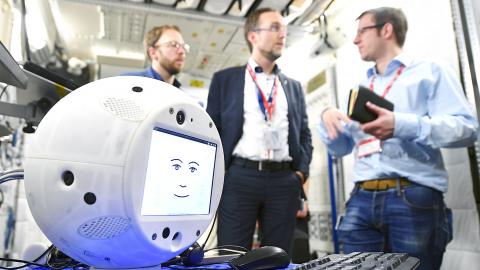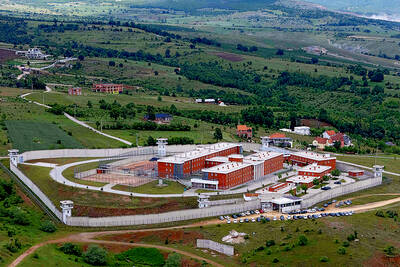A floating, ball-shaped robot, specially trained to follow a German astronaut around the International Space Station, blasted off yesterday on its ground-breaking mission.
The basketball-sized device called CIMON — shortened from “Crew Interactive MObile CompanioN” — was described as a “flying brain” by Manfred Jaumann, head of microgravity payloads at Airbus.
It launched from Cape Canaveral, Florida, yesterday at 5:42am, along with about 2,700kg of gear packed aboard SpaceX’s uncrewed Dragon cargo capsule.

Photo: AP/the German Aerospace Center
CIMON’s activation marks “a historical moment,” becoming the first robot of its kind to interact with people in space, said Christian Karrasch, CIMON project manager at the German Aerospace Center (DLR), during a NASA news briefing on Thursday.
A project in the works for the past two years, CIMON has been trained to recognize the voice and face of Alexander Gerst, 42, a geophysicist with the European Space Agency.
When Gerst calls CIMON, the floating robot acoustically senses where Gerst is calling from, orients itself and zooms over.
Hovering at the astronauts’ eye level, its front camera can detect if the person in front of it is indeed Gerst, or someone else.
CIMON is powered by more than a dozen propellers to help it jet around and avoid bumping into things inside the Columbus module of the space lab.
“This is designed to work in English. It understands Alexander,” said Bret Greenstein, global vice president of Watson Internet of Things Offerings at IBM. “It was helpful to train it to recognize him so that it will come to him when he speaks.”
All six crew members at the orbiting outpost can speak to CIMON, although it has been taught to work best with Gerst.
Experts say the experiment is more than just a smartphone-type device that follows astronauts around.
The metal and plastic intelligent robot, built using 3D printing, works together with people as a team, and allows astronauts to communicate hands-free via voice commands.
CIMON is to work with the space station’s Watson AI — IBM’s artificial intelligence technology — designed to support space flight crews.
Partners in the project include Airbus, DLR, IBM and the Ludwig Maximilians University of Munich.
The goal for this flight is mainly to demonstrate that the technology works.
Three experiments are planned: one using crystals, one with a Rubik’s cube and, finally, a medical experiment in which CIMON is to be employed as a flying camera, DLR said.
The robot is designed to guide Gerst through various science procedures and show videos or pictures as needed.
Gerst can also ask the robot questions beyond the simple procedure at hand.
CIMON is equipped with a microphone on the back, an infrared camera on the front, two batteries, and, perhaps most importantly, an offline button.
Once toggled to offline, Gerst can be sure nothing he is saying is streamed down to the IBM server on Earth.
Once back on, voice recordings are activated again.
CIMON is not yet trained to respond to all possible emergencies and protocols on the space station, researchers said, adding that the AI robot is programmed to learn, and they hope to further hone its capabilities in the years to come.

Packed crowds in India celebrating their cricket team’s victory ended in a deadly stampede on Wednesday, with 11 mainly young fans crushed to death, the local state’s chief minister said. Joyous cricket fans had come out to celebrate and welcome home their heroes, Royal Challengers Bengaluru, after they beat Punjab Kings in a roller-coaster Indian Premier League (IPL) cricket final on Tuesday night. However, the euphoria of the vast crowds in the southern tech city of Bengaluru ended in disaster, with Indian Prime Minister Narendra calling it “absolutely heartrending.” Karnataka Chief Minister Siddaramaiah said most of the deceased are young, with 11 dead

By 2027, Denmark would relocate its foreign convicts to a prison in Kosovo under a 200-million-euro (US$228.6 million) agreement that has raised concerns among non-governmental organizations (NGOs) and residents, but which could serve as a model for the rest of the EU. The agreement, reached in 2022 and ratified by Kosovar lawmakers last year, provides for the reception of up to 300 foreign prisoners sentenced in Denmark. They must not have been convicted of terrorism or war crimes, or have a mental condition or terminal disease. Once their sentence is completed in Kosovan, they would be deported to their home country. In

Brazil, the world’s largest Roman Catholic country, saw its Catholic population decline further in 2022, while evangelical Christians and those with no religion continued to rise, census data released on Friday by the Brazilian Institute of Geography and Statistics (IBGE) showed. The census indicated that Brazil had 100.2 million Roman Catholics in 2022, accounting for 56.7 percent of the population, down from 65.1 percent or 105.4 million recorded in the 2010 census. Meanwhile, the share of evangelical Christians rose to 26.9 percent last year, up from 21.6 percent in 2010, adding 12 million followers to reach 47.4 million — the highest figure

LOST CONTACT: The mission carried payloads from Japan, the US and Taiwan’s National Central University, including a deep space radiation probe, ispace said Japanese company ispace said its uncrewed moon lander likely crashed onto the moon’s surface during its lunar touchdown attempt yesterday, marking another failure two years after its unsuccessful inaugural mission. Tokyo-based ispace had hoped to join US firms Intuitive Machines and Firefly Aerospace as companies that have accomplished commercial landings amid a global race for the moon, which includes state-run missions from China and India. A successful mission would have made ispace the first company outside the US to achieve a moon landing. Resilience, ispace’s second lunar lander, could not decelerate fast enough as it approached the moon, and the company has